The thing that stands out most to me about Sri Lanka is how much variety you can pack into a single trip.
One day, you’re exploring ancient ruins. The next, you’re spotting elephants in a national park, hiking up a mountain surrounded by lush tea plantations, or snorkelling in warm tropical waters.
If you’re searching for the best places to visit in Sri Lanka, I’ve got plenty of suggestions. I recently spent four months there and have explored the island from top to bottom.
From the ancient ruins and cultural landmarks of Sigiriya, Polonnaruwa, and Anuradhapura to natural wonders in the mountains and along the coast, Sri Lanka is a tropical paradise just waiting to be discovered.
Table of Contents
Toggle- 1. Colombo
- 2. Sigiriya (Lion Rock)
- 3. Kandy
- 4. Ella
- 5. Galle
- 6. Nuwara Eliya
- 7. Yala National Park
- 8. Anuradhapura
- 9. Polonnaruwa
- 10. Arugam Bay
- 11. Bentota
- 12. Horton Plains National Park
- 13. Trincomalee
- 14. Adam’s Peak (Sri Pada)
- 15. Kalpitiya
- 16. Dambulla Cave Temple
- 17. Mirissa
- 18. Udawalawe National Park
- 19. Jaffna
- 20. Minneriya National Park
- FAQs
- When is the best time to visit Sri Lanka?
- Do I need a visa to visit Sri Lanka?
- What’s the best way to travel around Sri Lanka?
- Is Sri Lanka safe for solo travellers?
- What currency is used in Sri Lanka?
- Final Thoughts
Need help planning your next trip? Hire me as your Personal Travel Planner!
1. Colombo
I arrived in Colombo unsure of what to expect, but the city’s energy hit me the moment I stepped out of the airport.
Crowded streets, honking tuk-tuks, and the scent of mouthwatering food on every corner. Colombo is fun, lively, and full of character.
Start with Galle Face Green, a popular oceanfront park where locals gather to relax and enjoy the sea breeze.
It’s one of Colombo’s oldest public spaces, dating back to the British colonial era.
Strolling here at sunset gives you beautiful views over the Indian Ocean, and it’s a perfect spot to try Sri Lankan street snacks from the many vendors.
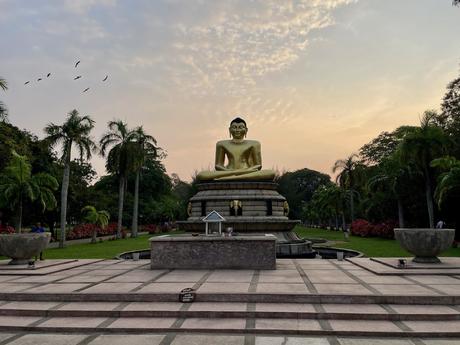
Gangaramaya Temple is another must-visit, with its distinctive mix of modern and traditional Buddhist architecture.
The temple complex includes a museum filled with artefacts and statues, offering insight into Sri Lanka’s religious and cultural heritage.
Pettah Market is Colombo’s lively and chaotic trading hub. You’ll find everything here, from fresh produce and textiles to electronics and jewellery.
Grab a tuk-tuk for easy navigation through the city’s busy streets.
I stayed at the (midrange and excellent) Mandarina Colombo hotel and would definitely recommend it.
2. Sigiriya (Lion Rock)
Sigiriya, or Lion Rock, is an ancient fortress and one of the most iconic and famous places to visit in Sri Lanka.
It’s certainly one of the most striking sights in the country. A huge rock fortress perched on top of a towering rocky hill that rises vertically from the jungle below.
Climbing Sigiriya is a rewarding (and moderately strenuous) experience.
The trail up the rock includes a series of stairs and terraces, passing beautiful ancient frescoes that depict celestial maidens, a fascinating relic of Sri Lanka’s history.
You’ll also pass the famous Lion’s Gate, where the remains of two massive lion paws flank the entrance to the summit.
At the top, you’ll find the ruins of a royal palace and panoramic views of the surrounding landscape and distant mountains.
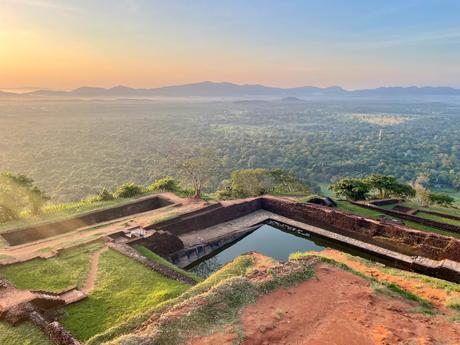
It’s easy to see why this site was chosen for a fortress – the views alone are worth the climb.
Take time to visit the Sigiriya Museum, which provides context on the site’s historical significance, with models and replicas of the ancient city.
Visit Sigiriya in the early morning or late afternoon to avoid the heat and crowds.
I did the climb in the early hours of the morning so I could enjoy the sunrise from the summit. I usually hate getting out of bed in the dark, but this was 100% worth it!
Bring plenty of water and wear sturdy shoes for the climb.
3. Kandy
The city of Kandy sits in the heart of Sri Lanka’s hill country, and it has a calm vibe that I love.
The Temple of the Sacred Tooth Relic is the spiritual centre of Kandy. It holds one of Buddha’s teeth, making it one of the most important sites for South Asian Buddhists.
Walking through the ornate halls, you’ll hear, see, and feel the reverence among the thousands of pilgrims.
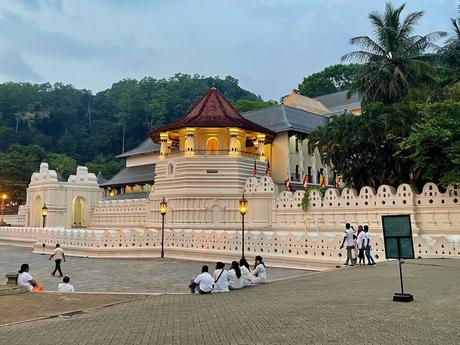
Kandy Lake is next door, with a peaceful path to wander around the shore. I enjoyed watching families feed the fish and seeing the subtle hum of daily life.
For nature lovers, the Royal Botanical Gardens in Peradeniya are a short ride away. They’re massive, with countless exotic plants and an orchid house I found mesmerising.
The best time to visit Kandy is between November and April when it’s usually drier, although showers are common year-round. If you visit in early August, the Esala Perahera festival is a colourful spectacle.
4. Ella
Ella is a laid-back hill town famous for its tea plantations, waterfalls, and scenic hikes.
I really enjoyed Ella’s cool, crisp air, lush tea plantations, chill cafes, and mountain views. It’s a perfect base for exploring the natural beauty of Sri Lanka’s hill country.
The Nine Arches Bridge is one of Ella’s iconic landmarks. This historic railway bridge, set among lush greenery, is a fantastic spot for photos, especially when the train passes over it.
A short walk from the town takes you to this picturesque viewpoint.
For a longer hike, I loved the trail to the summit of Ella Rock. The 8-kilometre trail leads through tea fields and forests, rewarding you with panoramic views of the surrounding mountains and valleys.
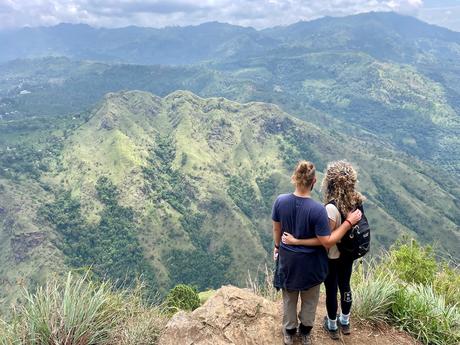
I recommend starting early to avoid the heat and enjoy the best views.
Ravana Falls, one of the widest waterfalls in Sri Lanka, is a refreshing spot to visit. You can cool off by the water or enjoy a scenic picnic by the falls, surrounded by jungle.
The scenic train ride from Kandy to Ella (or the reverse direction, for fewer crowds) is also a highlight.
You’ll enjoy breathtaking views of terraced fields, misty hills, and tea plantations along the way.
5. Galle
Galle is a historic coastal city on Sri Lanka’s southwestern coast, famous for its well-preserved Dutch fort and colonial architecture.
Galle Fort is the heart of the city’s history. This UNESCO-listed site was originally built by the Portuguese in the 16th century and later expanded by the Dutch in the 17th century.
It’s surrounded by thick stone walls that overlook the sea. Inside, you’ll find cobbled streets, colonial-era buildings, and quaint cafes.
The Galle Lighthouse, built in 1939 to replace an earlier structure, offers picturesque views of the ocean and nearby beaches.
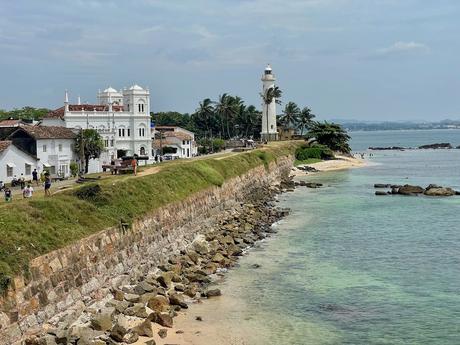
The Dutch Reformed Church is another highlight. This historic building was originally built by the Dutch in 1640. Its old tombstones and simple interior whisper stories of Galle’s past.
Exploring on foot or by bicycle lets you soak in the town’s laid-back vibe and admire its picturesque architecture.
Winter is the best season for visiting Galle, when the weather is cooler and drier.
6. Nuwara Eliya
Nuwara Eliya is a scenic hill station known for its tea plantations, cool climate, and colonial charm. It’s often called “Little England” due to its British influence.
Gregory Lake was originally built as a reservoir by the British in the 19th century. It’s a beautiful spot to relax and enjoy the fresh mountain air.
You can take a boat ride or simply stroll along the lake’s shores, surrounded by misty hills.
The tea estates in Nuwara Eliya are famous for producing some of the best high-altitude Ceylon tea in the world. Many plantations offer guided tours where you can learn about the tea-making process.
Victoria Park is another lovely spot, especially for nature lovers and birdwatchers. The park is filled with gorgeous flowers and shaded paths, perfect for a leisurely walk.
7. Yala National Park
Yala National Park is one of Sri Lanka’s top destinations for wildlife. It’s especially known for its population of leopards, one of the highest densities in the world.
A jeep safari, in the early morning or late afternoon, is the best way to explore Yala. Guides will take you along the park’s dirt tracks, where you can spot elephants, sloth bears, and countless bird species.
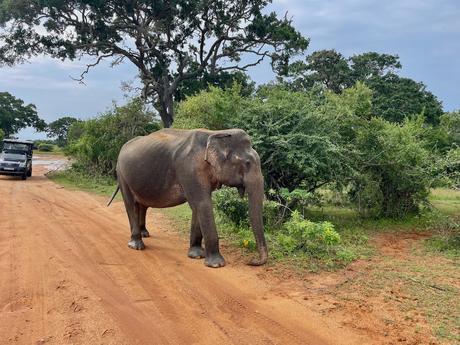
Yala’s landscapes are diverse, with scrub plains, wetlands, and rocky outcrops.
If possible, I recommend visiting in the dry season, from February to July, when sightings of big cats are more common and the weather is less humid.
Be sure to book your safari and accommodation in advance, especially in peak season. It’s a very popular destination and the best hotels and guesthouses book up fast.
8. Anuradhapura
Anuradhapura blew me away with its ancient ruins and the spiritual atmosphere that hangs in the air.
Anuradhapura is one of Sri Lanka’s ancient capitals, famous for its impressive ruins and sacred temples.
If you’re into history, you’ll love exploring the centuries-old stupas and remnants of past civilisations.
The Sri Maha Bodhi is one of my favourite places in Anuradhapura. It’s believed to be a direct descendent of the tree under which Buddha found enlightenment. It’s also the oldest living tree with a recorded planting date (288 BC).
There’s an incredible atmosphere around the tree, and a sense of collective reverence. Pilgrims come here to make offerings and pray. The air is full of chanting and incense, with colourful arrangements of flowers everywhere.
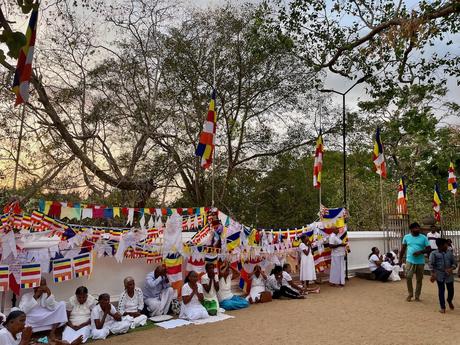
Ruwanwelisaya Stupa, one of the largest stupas in the world, is another must-see. Its bright white dome stands out against the sky and pilgrims circle the structure with offerings of lotus flowers.
The ancient ruined Abhayagiri Monastery is also worth exploring.
Once home to thousands of monks, this site was an important monastic complex and one of the island’s three major Buddhist centres during the 1st millennium CE.
Many sites in Anuradhapura are sacred, so remember to dress modestly and respect the local customs.
9. Polonnaruwa
Polonnaruwa, another ancient capital of Sri Lanka, is famous for its well-preserved ruins and fascinating sculptures.
This UNESCO World Heritage site is an open-air museum of Sri Lanka’s history.
The Gal Vihara is one of the highlights, featuring four impressive Buddha statues carved out of a single granite rock. These detailed statues are considered masterpieces of ancient Sri Lankan art.
The Royal Palace ruins offer a glimpse into the grandeur of Polonnaruwa’s past. Walking through the remnants of the palace walls, it’s easy to imagine the opulence of the ancient kingdom.
The Vatadage, an intricately decorated circular relic house, is considered an architectural masterpiece of Polonnaruwa’s golden age. It’s intricately decorated with carvings and houses a sacred stupa in its centre.
Visit Polonnaruwa in the morning or late afternoon to avoid the heat. Renting a bike is a fun way to explore the expansive ruins and see more in a shorter time.
10. Arugam Bay
Arugam Bay is a laid-back beach town on Sri Lanka’s east coast, famous for its excellent surfing and relaxed vibes.
It’s often considered one of the top surfing destinations in the world.
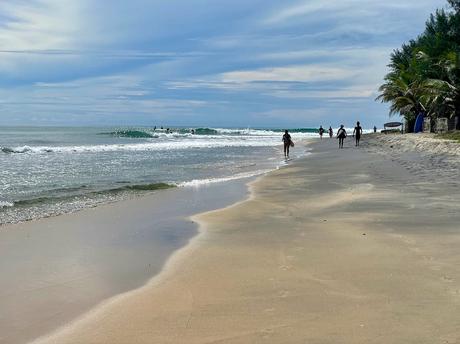
The main beach has a lively atmosphere, with beach cafes and a surf scene focused on the iconic Main Point. This incredible, long and clean wave attracts travellers from around the globe.
Sitting in the lineup, you’ll hear many different languages spoken: English, Tamil, Sinhala, French, Spanish, German, Russian, Portuguese, Hebrew, Dutch – you name it.
If you’re a surfer, you will absolutely love this place. I spent three weeks surfing here and wish it could’ve been longer.
Surf lessons are available for all levels, from beginner to advanced. And aside from Main Point, there are several other waves to practice on, especially if (like me) you aren’t that great on a board. Peanut Farm is one of my favourites.
Kumana National Park, located nearby, is great for a day trip. It’s home to over 200 species of birds and various other wildlife.
Peak surf season usually runs from May to September, so book your accommodation early if you want to ride the best waves. I came at the end of April, and it was quieter, but not all of the breaks were working.
11. Bentota
Bentota is a beautiful beach destination on Sri Lanka’s southwest coast with golden sands and a very chill vibe.
Bentota Beach is perfect for swimming, sunbathing, and watersports. The calm waves make it suitable for jet skiing, snorkelling, and other activities.
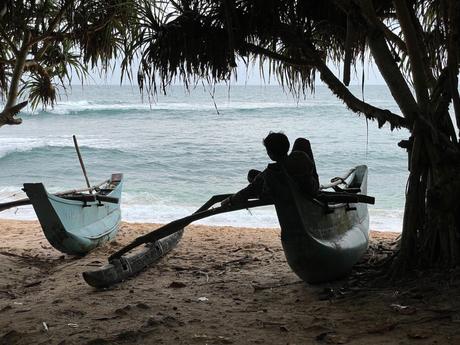
Brief Garden, created by Bevis Bawa, is another hidden gem, with landscaped paths and quirky sculptures. It’s well worth a visit if you fancy a break from the beach scene.
The Bentota River is also a highlight. You can take a river cruise to spot wildlife like birds and monitor lizards.
The best time to visit Bentota is from November to April, when the weather is perfect for beach activities, and the water is calm.
12. Horton Plains National Park
Horton Plains National Park is a beautiful highland plateau known for its wide grasslands, scenic hiking trails, and misty landscapes.
The main attraction is the World’s End viewpoint, where the plateau drops abruptly by about 1,000 metres, offering breathtaking views over the valley below.
On clear days, you can see for miles, making the early start worthwhile.
Baker’s Falls is a picturesque waterfall located along the main trail. This picturesque waterfall is surrounded by lush greenery and is a peaceful spot to take a break.
The park is home to diverse wildlife, including sambar deer, purple-faced langurs, and various bird species. Keep an eye out as you explore the trails.
Visit early in the morning for the best chance of clear views, as the weather tends to be misty later in the day.
Bring sturdy shoes and dress warmly – mornings in Horton Plains can be chilly.
13. Trincomalee
Trincomalee sits on Sri Lanka’s northeast coast, and is more laid-back than some of the busier beach spots down south.
Nilaveli Beach is my favourite place for a relaxed swim or an early morning wander, with sand so soft it’s like stepping on powder.
For a unique underwater experience, head to Pigeon Island Marine Park.
This park offers excellent snorkelling and diving, with live corals and an abundance of other marine life including colourful tropical fish and friendly black-tipped reef sharks.
Koneswaram Temple, perched on a cliff overlooking the sea, offers beautiful ocean views. It’s one of the most important Hindu pilgrimage sites in Sri Lanka, with a history dating back to ancient times.
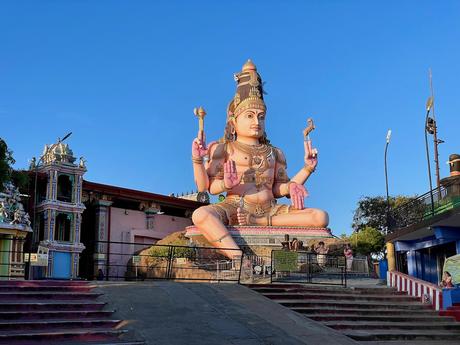
Trinco also has many excellent restaurants and informal eateries where you can feast on fresh crab and tangy prawn curries.
Eastern Lanka Seafood Restaurant is one of my favourite spots to eat in Trincomalee. It’s located in the Uppuveli area, and everything on the menu is excellent value and delicious.
14. Adam’s Peak (Sri Pada)
Adam’s Peak, also known as Sri Pada, is a sacred mountain and popular pilgrimage site in Sri Lanka.
The trek up Adam’s Peak is challenging but rewarding, especially if you time it to enjoy sunrise from the summit.
with about 5,200 steps leading you to the summit for sunrise.
The trek begins in the early hours of the morning, and you’ll pass about 5,200 steps leading up the mountain. There’s a friendly and communal atmosphere with local devotees and other travellers chatting quietly in the cool darkness.
Reaching the summit at sunrise is breathtaking. On clear days, you’ll witness the famous “shadow of the peak,” a triangular shadow cast by the mountain, along with panoramic views of the surrounding hills.
Adam’s Peak holds spiritual significance for Buddhists, Hindus, and Christians, making it a place of unity and reverence.
Trekking season is from December to May. Start early (around 3 am) to reach the peak before sunrise, and bring layers as it can get chilly at higher altitudes.
15. Kalpitiya
Kalpitiya is a coastal town on Sri Lanka’s northwest coast, known for its dolphin and whale watching, kitesurfing, and beautiful lagoons.
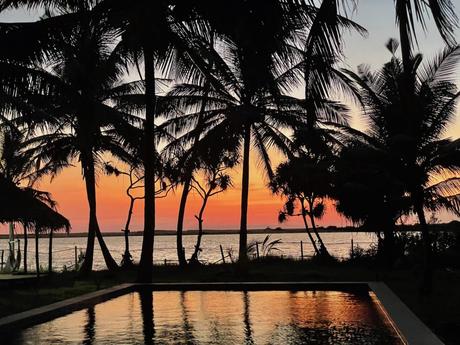
During the winter months, large pods of spinner dolphins swim and play near the coast – an unforgettable sight.
Kalpitiya is also a popular spot for kitesurfing, with strong winds and shallow waters that attract kitesurfers from around the world.
Several schools in the area offer lessons for beginners and equipment rental.
The nearby Kalpitiya Lagoon is perfect for a peaceful paddle or kayaking trip. You can enjoy the serene water surrounded by mangroves and spot various bird species.
Visit Kalpitiya from November to April for dolphin watching, and from May to September for prime kitesurfing conditions.
16. Dambulla Cave Temple
Dambulla Cave Temple is among Sri Lanka’s most cherished Buddhist sites.
The complex features five rock-cut caves adorned with vivid murals and numerous Buddha statues, each cave showcasing centuries-old artistic traditions.
A towering Golden Buddha greets you at the entrance. I climbed the steps just after sunrise and felt a calm wash over me when I entered the first cave.
Inside, I was struck by the intricate details on the walls, particularly the scenes from the Buddha’s life. A faint scent of incense added to the peaceful mood.
Visiting in the early morning helps you avoid the midday heat and any big tour groups. Wear modest clothes, bring water for the short climb, and remember to leave your shoes at the door.
17. Mirissa
Mirissa is a beautiful beach town on Sri Lanka’s southern coast. It’s a popular destination known for its soft sands and whale-watching tours.
Early morning boat tours give you the chance to see various species of whales and dolphins in their natural habitat.
Mirissa is one of the best places in the world to see blue whales, especially during the peak season (November to April). I was particularly excited to see one of these rare and elusive creatures in the wild.
Sadly, we didn’t see any on my trip, but we did see a fin whale (the second-largest whale species), plus several humpbacks and plenty of dolphins and turtles.
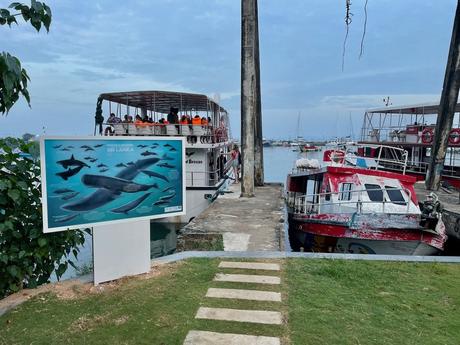
Aside from whale watching, Mirissa Beach is perfect for sunbathing, swimming, and relaxing. With golden sand and clear waters, it’s a great place to unwind and soak up the tropical atmosphere.
Coconut Tree Hill, a scenic viewpoint overlooking the ocean, is a popular spot. The iconic palm trees against the sea make for a perfect tropical shot.
18. Udawalawe National Park
Udawalawe National Park is one of the best places in Sri Lanka to see elephants in their natural habitat.
A jeep safari is the best way to explore Udawalawe. You’ll have the chance to spot elephants, water buffalo, deer, eagles, and a variety of other bird species as you journey through the park.
The landscapes in Udawalawe vary from open grasslands and marshes to forested areas. This variety is one of the key reasons why it’s such an important natural habitat for wildlife.
Try to visit during the dry season from May to September, when animals are easier to spot as they gather around the remaining water sources.
Book your safari in advance to ensure a spot.
19. Jaffna
Jaffna is a culturally rich city in northern Sri Lanka, known for its Tamil heritage, historic temples, and quiet beaches.
It feels totally different from the country’s southern regions, offering a unique and immersive glimpse into Sri Lankan Tamil culture. Very few tourists come here too, making it a fantastic off-the-beaten-path destination.
Nallur Kandaswamy Temple is one of Jaffna’s most significant landmarks. This colourful Hindu temple is dedicated to Lord Murugan and is an important site for local worshippers.
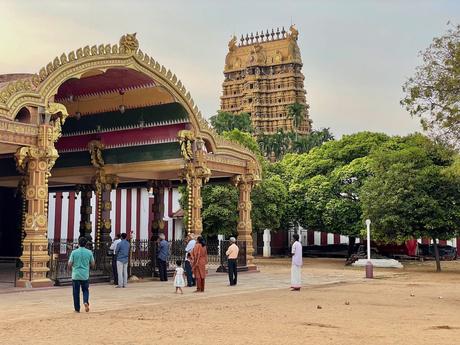
Jaffna Fort, built by the Portuguese and later expanded by the Dutch, offers insights into the city’s colonial history. From the fort’s walls, you can enjoy panoramic views of Jaffna town and the surrounding area.
Casuarina Beach, a quiet beach near Jaffna, is known for its peaceful vibe and the Casuarina trees lining the shore. It’s a perfect place to relax by the sea.
20. Minneriya National Park
Minneriya National Park is famous for its annual “Gathering” of elephants.
Here, hundreds of elephants come together near the Minneriya Tank, one of Sri Lanka’s largest reservoirs. It’s a remarkable natural spectacle.
A jeep safari in Minneriya offers the chance to see elephants up close, along with other wildlife like deer, buffalo, and tropical birds.
The park’s open landscapes make it easier to spot animals and enjoy uninterrupted views.
Visit Minneriya from July to October for the best chance of witnessing the elephant Gathering. The dry season draws animals to the central reservoir, creating this unique spectacle.
FAQs
When is the best time to visit Sri Lanka?
The best time to visit Sri Lanka depends on which region you’re exploring. For the west and south coasts, December to March offers ideal weather, while the east coast is best visited from April to September.
Do I need a visa to visit Sri Lanka?
Most nationalities need an Electronic Travel Authorization (ETA) to enter Sri Lanka. This can be arranged quickly online and is essential for a hassle-free arrival.
What’s the best way to travel around Sri Lanka?
Trains, buses, and private taxis are common and efficient ways to travel around Sri Lanka. Renting a car with a driver is also a popular option, offering greater flexibility and convenience, especially for longer journeys. Scenic train rides, especially between Kandy, Ella, and Colombo, are highly recommended for their breathtaking views of the countryside and hills.
Is Sri Lanka safe for solo travellers?
Sri Lanka is generally safe for solo travellers, but like any destination, it’s advisable to take basic precautions. Solo female travellers should exercise extra caution in rural areas and avoid isolated places at night.
What currency is used in Sri Lanka?
The currency used in Sri Lanka is the Sri Lankan rupee (LKR). ATMs are widely available in cities, but it’s wise to carry cash when visiting rural areas, where card payment options are often limited.
Final Thoughts
Sri Lanka is a beautiful and fascinating island nation offering a wealth of diverse attractions, from ancient temples and vibrant cities to pristine beaches and rich wildlife reserves.
To truly experience Sri Lanka, try to explore both its well-known highlights and a few of its hidden gems. Each location offers something different.
Check out some of my other posts on Sri Lanka and let me help you plan an unforgettable trip!

